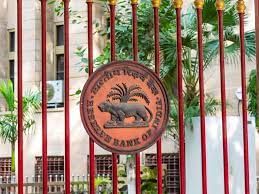UPSC Daily Current Affairs- 31st May 2023 | Current Affairs & Hindu Analysis: Daily, Weekly & Monthly PDF Download
GS-I
Delhi’s Ancient Secrets: Recent Excavations at Purana Qila
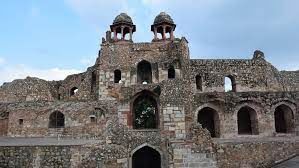
Why in News?
Delhi’s Purana Qila, also known as the Old Fort, is a historic site with a rich and diverse past.
- Recent excavations have shed light on its continuous history since the pre-Mauryan era.
About Purana Qila
- The origins of Purana Qila date back to antiquity, with the exact foundation period unknown.
- It was later rebuilt by Sher Shah Suri and Mughal emperor Humayun.
- The fort holds immense cultural and historical importance, and many believe it to be the site of Indraprastha mentioned in the Mahabharata.
- The fort, believed to be the location of the ancient city of Indraprastha, showcases architectural remnants from various periods, including the Mughal and Rajput eras.
Architectural marvels at Purana Qila
- Purana Qila’s architectural features include walls that rise to a height of 18 meters, spanning approximately 1.5 kilometers.
- It boasts three arched gateways, including the Bara Darwaza, the south gate (Humayun Gate), and the Talaqi Gate.
- The fort’s Qila-i-Kuhna Mosque, built by Sher Shah Suri in 1541, showcases pre-Mughal architecture with its pointed arches and elegant prayer niches.
- The Sher Mandal, a double-storeyed octagonal tower, served as Humayun’s private observatory and library.
- It features decorative plaster-work and remnants of stone shelving for books.
Recent excavation discoveries
- Excavations have uncovered significant artifacts, including shards of Painted Gray Ware pottery dating from 1200 BC to 600 BC, indicating the pre-Mauryan period.
- Other discoveries include a 900-year-old Vaikuntha Vishnu from the Rajput period, a terracotta plaque of Goddess Gaja Lakshmi from the Gupta period, and a 2,500-year-old terracotta ring well from the Mauryan period.
- Numerous beads, seals, copper coins, and a bone needle have also been found, highlighting the site’s role as a center for trade activities.
Cultural chronology and preservation
- The ongoing excavation aims to establish a complete chronology of the site, spanning different historical periods from the Kushan to the Mughal era.
- The remains of Purana Qila will be preserved, conserved, and transformed into an open-air museum to showcase the rich historical legacy of Delhi.
- The excavated artifacts will also be displayed to delegates attending the G-20 summit, further promoting the cultural heritage of the site.
Source: The Hindu
GS-II
75th anniversary of United Nations peacekeeping missions
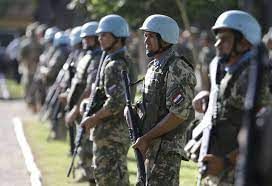
Why in News?
Recently the United Nations observed the 75th anniversary of its peacekeeping missions.
About UN Peace keeping:
- The International Day of UN Peacekeepers is observed annually on May 29th. It is a day dedicated to honouring the contributions and sacrifices of United Nations (UN) peacekeepers in maintaining peace and security around the world.
- The day also serves as a tribute to those who have lost their lives in the line of duty.
- The theme of the 75th anniversary “Peace begins with me” recognizes the service and sacrifice of peacekeepers, past and present, including more than 4200 who have given their lives under the UN flag.
- It also pays tribute to the resilience of the communities that we serve, who continue to strive for peace despite many obstacles.
- This campaign also calls on each of us to join the global movement for peace. Alone, we can never succeed.
- But, together, we can be a strong force for change.
Progress till now:
- For 75 years, UN peacekeepers have saved and changed lives in the world’s most fragile political and security situations.
- Peacekeeping is flexible and over the past two decades has been deployed in many configurations.
- Today’s multidimensional peacekeeping operations are called upon not only to maintain peace and security, but also to facilitate the political process, protect civilians, assist in the disarmament, demobilization and reintegration of former combatants; support the organization of elections, protect and promote human rights and assist in restoring the rule of law.
Significance of UN peacekeeping missions:
- Recognizing Peacekeeping Efforts: The day serves as a global recognition of the crucial role played by UN peacekeepers in maintaining peace and security around the world. It acknowledges their commitment and tireless efforts in preventing conflicts, protecting civilians, and promoting stability in areas affected by violence and war.
- Honouring Fallen Peacekeepers: The International Day of UN Peacekeepers is an occasion to honor and remember those peacekeepers who have lost their lives in the line of duty.
- It pays tribute to their bravery and sacrifice, emphasizing the profound impact they have made in the pursuit of peace.
- The day offers an opportunity to express gratitude and support to the families and loved ones of fallen peacekeepers.
- Promoting Awareness and Understanding: The day raises awareness about the challenges faced by UN peacekeepers and the complex nature of their work.
- It helps foster understanding and appreciation among the general public, highlighting the significance of peacekeeping operations in resolving conflicts and preventing the escalation of violence.
- Advocating for Peace and Security: The International Day of UN Peacekeepers serves as a platform for advocating peace and security at the international level.
- It encourages governments, organizations, and individuals to recommit themselves to the principles of peacekeeping and to strengthen their support for UN peacekeeping missions.
- Strengthening International Peacekeeping: The day provides an opportunity to reflect on the achievements, challenges, and future directions of UN peacekeeping.
- It encourages discussions and dialogue on improving the effectiveness and efficiency of peacekeeping operations, including the development of new strategies, technologies, and approaches.
- The day’s significance lies in its role as a catalyst for advancing the field of international peacekeeping and promoting continuous improvement in peacekeeping practices.
Challenges:
- UN peacekeeping faces increasingly difficult challenges, including attacks against our peacekeepers, complex mandates, and uneven political support.
- Peacekeeping is essentially a collective endeavour: a partnership.
- The Charts below show the number of peacekeepers, country-wise, who died due to malicious acts during peacekeeping missions.
Way Forward:
We require strong, collective action if we are to succeed in addressing the existing challenges. Strengthening peacekeeping means helping countries who provide us with troops and police, including by supporting training needs to ensure we deploy personnel equipped and prepared to accomplish these tasks.
Thus, ensuring that all United Nations personnel maintain the highest standards of conduct must be at the heart of our collective efforts. We must continue to work harder and closely with Member States who possess the authority to hold all categories of personnel accountable for criminal conduct.
Source: The Hindu
Cambodian King’s state visit to India
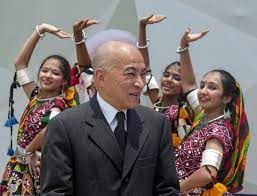
Why in News?
Cambodian King Norodom Sihamoni is on his maiden state visit to India to mark the culmination of 70th anniversary of diplomatic relations with India.
Marking 70th Anniversary of Diplomatic Ties
- This visit holds special significance as it is the first state visit by a Cambodian King in nearly six decades, with the last visit being made by King Norodom Sihamoni’s father in 1963.
- India and Cambodia share warm and friendly relations, characterized by deep-rooted people-to-people ties, cultural connections, and a commitment to mutual economic growth.
India-Cambodia Diplomatic Ties: A Backgrounder
[A] Historical Background
| Additional Information | |
| Indianization of Southeast Asia | Spread of Indian religions, cultural practices, art, architecture, and literature across Southeast Asia |
| Funan Kingdom (1st to 6th century CE) | Indian traders establishing commercial links with Funan, leading to the exchange of goods, ideas, and cultural practices |
| Chenla Kingdom (6th to 9th century CE) | Emergence of Chenla as an Indianized kingdom with continued Indian cultural and religious influence |
| Khmer Empire (9th to 15th century CE) | Peak of Indian influence, adoption of Hinduism and later Buddhism, construction of monumental temples and structures like Angkor Wat |
| Sanskrit Inscriptions and Literature | Adoption of Sanskrit as court language, creation of inscriptions and literary works in Sanskrit |
| Cultural Exchange and Artistic Influence | Indian art, architecture, and performing arts influencing Cambodian temples, sculptures, and dance forms |
| Royal Ties and Religious Connections | Close connections between ruling elites of the Khmer Empire and Indian kingdoms, the transmission of Buddhist teachings and scriptures from India |
[B] Diplomatic Relations
- Establishment of Diplomatic Ties: India and Cambodia established diplomatic relations in 1952 after Cambodia’s independence from French colonial rule.
- High-Level Visits: Frequent visits by Indian Prime Ministers and Presidents to Cambodia and vice versa to strengthen bilateral relations and political dialogue.
- Bilateral Agreements: Signing of agreements covering areas such as economic cooperation, cultural exchanges, defense, and tourism.
- Resident Diplomatic Missions: Indian Embassy in Phnom Penh and Cambodian Embassy in New Delhi facilitating regular communication and coordination.
- Regional and Multilateral Engagement: Collaboration within organizations like ASEAN and East Asia Summit, providing platforms for regional cooperation and addressing challenges.
Various facets of India-Cambodia Relations
(1) Economic Cooperation
- Growing Bilateral Trade: Focus on sectors like textiles, pharmaceuticals, automobiles, agriculture, and information technology.
- Development Assistance: India’s support in sectors like agriculture, irrigation, human resource development, and capacity building.
- Investment and Joint Ventures: Exploring opportunities for investment and collaborative projects.
(2) Defense and Security Cooperation
- Training and Capacity Building: Defense cooperation through training programs for Cambodian armed forces personnel.
- Defense Dialogues and Exchanges: Regular engagement in discussions on maritime security, counter-terrorism, and defense industry collaboration.
(3) Cultural and Educational Exchanges
- Art, Music, Dance, and Literature: Fostering cultural ties through exchanges and appreciation of each other’s cultural heritage.
- Scholarships and Education: ICCR scholarships facilitate Cambodian students’ higher education in India.
- People-to-People Connections: Cultural festivals, events, and tourism enhance mutual understanding and interactions.
Strategic significance of Cambodia for India
- Geostrategic Location: Cambodia’s position in Southeast Asia provides India with access to crucial sea routes and enhances its engagement in the Indo-Pacific region.
- Regional Connectivity: Cambodia’s connectivity with other ASEAN countries allows India to strengthen regional partnerships and facilitate trade, investment, and people-to-people exchanges as part of its Act East Policy.
- Balancing China’s Influence: Strengthening relations with Cambodia enables India to maintain a balanced approach and counterbalance China’s growing influence in the region.
- Maritime Security: Cambodia’s coastal geography and access to the Gulf of Thailand are strategically important for India’s maritime security concerns. Cooperation with Cambodia supports regional stability and ensures the safety of vital sea routes.
- Economic Engagement: Cambodia’s growing economy and investment potential offer opportunities for India to enhance economic cooperation, boosting trade, investments, and joint ventures for mutual benefit.
- Cultural Diplomacy: Cambodia’s historical and cultural linkages with India provide a foundation for strong cultural and people-to-people ties, enhancing India’s soft power in the region.
- Defense and Security Cooperation: Collaborating with Cambodia in defence and security areas contributes to regional security, including capacity building, joint exercises, and information sharing.
Way Forward
- Strengthen Economic Ties: Expand bilateral trade and investment, explore new sectors, and foster business partnerships.
- Enhance Defense Cooperation: Continue training and capacity-building programs, and deepen discussions on shared security challenges.
- Cultural Exchanges and Tourism: Promote greater cultural understanding, organize more cultural events, and facilitate tourism exchanges.
- People-to-People Contacts: Encourage more interactions between citizens, foster academic collaborations, and promote tourism.
- Regional Cooperation: Engage actively within ASEAN and other regional forums to address common challenges and pursue shared interests.
Source: The Hindu
Article 299 of the Constitution: Can the govt claim immunity when entering contracts under the President’s name?
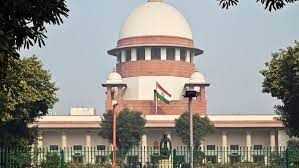
Why in News?
The Supreme Court held that the government, when entering into a contract under the President’s name, cannot claim immunity from the legal provisions of that contract under Article 299 of the Constitution.
What is Article 299 of the Indian Constitution?
- Article 298: It grants the Centre and the state governments the power to carry on trade or business, acquire, hold, and dispose of property, and make contracts for any purpose.
- Article 299: It provides that all contracts made in the exercise of the executive power of the Union or of a State shall be
- Expressed to be made by the President or by the Governor of the State.
- Executed on behalf of the President or the Governor by persons in a manner as directed and authorised by them [Article 299 (1)].
Procedure to be Followed for Making a Contract:
- In 1954, the top court held that there must be a definite procedure according to which contracts must be made by agents acting on the government’s behalf; otherwise, public funds may be depleted by illegitimate contracts.
- It implies that contracts not adhering to the manner given in Article 299(1) cannot be enforced by any contracting party.
- However, Article 299 (2) says that neither the President nor the Governor can be personally held liable for such contracts.
What are the Requirements for Government or State Contracts?
- In 1966, the apex court laid down essential requirements for government contracts under Article 299.
- 3 conditions to be met before a binding contract against the government could arise:
- The contract must be expressed to be made by the Governor or the President;
- It must be executed in writing, and
- The execution should be by such persons and in such a manner as the Governor or the President might direct or authorise.
What was the Case?
- The case dealt with an application filed by Glock Asia-Pacific Limited, a pistol manufacturing company, against the Centre regarding the appointment of an arbitrator in a tender-related dispute.
- According to the Arbitration and Conciliation Act, 1996, any person whose relationship with the parties or counsel of the dispute falls under the 7th Schedule (of the Act) will be ineligible to be appointed as an arbitrator.
- The 7th Schedule includes relationships where the arbitrator is an employee, consultant, advisor, or has any other past or present business relationship with a party.
The Apex Court’s Ruling:
- Referring to the 246th Law Commission Report, the court observed that when the party appointing an arbitrator is the State, the duty to appoint an impartial and independent adjudicator is even more onerous.
- Thus, the court rejected the Centre’s reliance on Article 299, saying that Article 299 only lays down the formality that is necessary to bind the government with contractual liability.
- Thus, the substantial law relating to the contractual liability of the Government is to be found in the general laws of the land.
- The court also appointed former SC judge Justice Indu Malhotra “as the Sole Arbitrator to adjudicate upon the disputes” in the case.
Source: The Hindu
GS-III
RBI’s lightweight payment and settlements system
Why in News?
The Reserve Bank of India (RBI) has conceptualised a lightweight payment and settlements system, which it is calling a “bunker” equivalent of digital payments.
- The central bank has not offered a timeline for the launch of this payments system yet.
Payment and settlements system in India
- About
- Payment and settlement systems refer to the infrastructure and processes that enable the transfer of funds and the settlement of financial transactions between individuals, businesses, and financial institutions.
- An efficient payment system promotes market efficiency and reduces the cost of exchanging goods and services.
- By the same token, its failure can result in loss of confidence in the financial system and in the very use of money.
- India's payment and settlement system has witnessed remarkable growth, driven by technological advancements, government initiatives, and changing consumer preferences.
- Regulatory framework
- The Reserve Bank of India (RBI) regulates and oversees the payment and settlement systems in the country.
- The Board for Regulation and Supervision of Payment and Settlement Systems (BPSS), chaired by the Governor, RBI, spearheads this responsibility.
- In 2005, RBI created Department of Payment and Settlement Systems (DPSS) to focus exclusively on payment and settlement systems.
- Subsequently, the government enacted the Payment and Settlement Systems Act, 2007 (PSS Act).
- The Reserve Bank of India (RBI) regulates and oversees the payment and settlement systems in the country.
Components of Payment and Settlement Systems
- Paper-based Payments
- Use of paper-based instruments (like cheques, drafts, and the like) accounts for nearly 60% of the volume of total non-cash transactions in the country.
- Electronic Clearing Service (ECS) Credit
- Later in 2008, RBI launched a new service known as National Electronic Clearing Service (NECS).
- National Electronic Funds Transfer (NEFT) System (launched in 2005)
- Available across a longer time window, the NEFT system provides for batch settlements at hourly intervals, thus enabling near real-time transfer of funds.
- Real Time Gross Settlement (RTGS)System (introduced in in 2004)
- RTGS is a funds transfer systems where transfer of money takes place from one bank to another on a real time (no waiting time) and on gross basis.
- Clearing Corporation of India Limited (CCIL)
- CCIL was set up in April 2001 by banks, financial institutions and primary dealers.
- It was established to function as an industry service organisation for clearing and settlement of trades in money market, government securities and foreign exchange markets.
- Immediate Payment Service (IMPS) – Launched in 2010
- IMPS is an interbank electronic funds transfer system that enables instant money transfers 24/7.
- Other Payment Systems
- Pre-paid Payment Systems
- Mobile Banking System
- ATMs / Point of Sale (POS) Terminals / Online Transactions
- Unified Payments Interface (UPI): UPI is a real-time payment system developed by the National Payments Corporation of India (NPCI).
- Mobile Wallets: Mobile wallets, such as Paytm, PhonePe, and Google Pay, have become increasingly popular in India.
- Aadhaar Enabled Payment System (AEPS): AEPS is a biometric-based payment system that leverages the UIDAI Aadhaar database.
News Summary: RBI’s lightweight payment and settlements system
- In a proactive move to address potential disruptions caused by catastrophic events or volatile situations, the RBI has unveiled a new initiative: the Lightweight Payment and Settlement System (LPSS).
- This new system can be operated from anywhere by a bare minimum staff in exigencies such as natural calamities or war.
- The infrastructure for this system will be independent of the technologies that underlie the existing systems of payments such as UPI, NEFT, and RTGS.
Need for such a lightweight payments system
- According to the RBI, existing conventional payments systems such as RTGS, NEFT, and UPI are designed to handle large volumes of transactions while ensuring sustained availability.
- As a result, they are dependent on complex wired networks backed by advanced IT infrastructure.
- However, catastrophic events like natural calamities and war have the potential to render these payment systems temporarily unavailable by disrupting the underlying information and communication infrastructure.
- Therefore, it is prudent to be prepared to face such extreme and volatile situations.
Benefits of such a lightweight payments system
- Could ensure near zero downtime of the payment and settlement system
- In its Annual Report for 2022-23, RBI says that the lightweight and portable payment system is expected to operate on minimalistic hardware and software, and would be made active only on a need basis.
- Hence, such a lightweight and portable payment system could ensure near zero downtime of the payment and settlement system in the country.
- Can keep the liquidity pipeline of the economy alive
- It has potential to keep the liquidity pipeline of the economy alive and intact.
- It can do so by facilitating uninterrupted functioning of essential payment services like bulk payments, interbank payments and provision of cash to participant institutions.
- Can ensure stability of the economy
- The system is expected to process transactions that are critical to ensure the stability of the economy, including government and market related transactions.
- Can enhance public confidence in digital payments
- Having such a resilient system is also likely to act as a bunker equivalent in payment systems.
- Hence, it can enhance public confidence in digital payments and financial market infrastructure even during extreme conditions.
Source: Economic Times
India discovers TOI 4603b Exoplanet

Why in News?
A new Jupiter-size exoplanet with the highest density known till this date has been discovered by an international team of scientists at the Exoplanet Research Group of the Physical Research Laboratory (PRL), Ahmedabad.
- Massive giant exoplanets are defined as those with a mass greater than four times that of Jupiter.
About the Exoplanet TOI4603b
- The exoplanet is found around the star called TOI4603 or HD 245134.
- It has a mass 13 times greater than that of Jupiter and a density of approximately 14 g/cm3.
- Initially, NASA’s Transiting Exoplanet Survey Satellite (TESS) declared TOI4603 as a possible candidate to host a secondary body of unknown nature.
- Using PARAS, scientists confirmed the secondary body as a planet, and it was named TOI 4603b or HD 245134b.
- The exoplanet is located 731 light years away and orbits a sub-giant F-type star TOI4603 every 7.24 days.
Note: An exoplanet, short for “extra-solar planet,” is a planet that orbits a star other than our Sun. These planets are located outside of our solar system and are not part of our planetary system.
Unprecedented Density and Proximity
- TOI 4603b is one of the most massive and densest giant planets discovered to date.
- It orbits very close to its host star at a distance less than 1/10th the distance between our Sun and Earth.
- Comparisons between the TOI-4603 star-planet system and the Sun-Mercury and Sun-Jupiter systems highlight the close proximity of TOI-4603 b to its star.
- The exoplanet is situated more than 50 times closer to its star than Jupiter is to the Sun.
- TOI-4603b is 13 times more massive than Jupiter.
Utilization of Indigenous Technology
- The discovery of this massive exoplanet was made using the indigenously made PRL Advanced Radial-velocity Abu-sky Search spectrograph (PARAS) at the 1.2 m telescope of PRL at its Gurushikhar Observatory in Mt. Abu.
- The mass of the planet was measured precisely using PARAS.
Uniqueness of the Discovery
- The planet falls into the transition mass range of massive giant planets and low-mass brown dwarfs, with masses ranging from 11 to 16 times the mass of Jupiter.
- Only fewer than five exoplanets are currently known in this mass range.
- The rarity of such discoveries makes this finding significant.
Insights into Formation and Evolution
- The exoplanet has a surface temperature of 1670 K and is likely undergoing high-eccentricity tidal migration with an eccentricity value of approximately 0.3.
- The detection of such systems provides valuable insights into the formation, migration, and evolution mechanisms of massive exoplanets.
India’s Contribution to Exoplanet Discoveries
- This marks the third exoplanet discovery by India and the PRL scientists using the PARAS spectrograph and the PRL 1.2m telescope.
- Previous discoveries include K2-236b in 2018 and TOI-1789b in 2021.
Source: The Hindu
Great Himalayan National Park
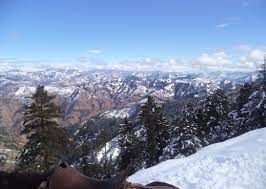
Why in News?
An Interpretation Centre has been developed in the Sainj valley of the Great Himalayan National Park (GHNP) at Sainj Ropa in Kullu district.
- The Interpretation Centre gives information about the flora and fauna found in the GHNP. It will focus on orchids and medicinal plants, along with birds and beautiful locations.
About Great Himalayan National Park (GHNP)
- It was established in 1984 and in 2014 accorded UNESCO World Heritage site status under the criteria of exceptional natural beauty and conservation of biological diversity.
- It’s located in Kullu region of Himachal Pradesh state.
- Species found : Himalayan brown bear, Himalayan tahr, blue sheep, snow leopard, birds and musk deer
- The vegetation like the lofty pines, spruces and the horse chestnuts of the lower valleys, to the dense cushions and prostrate branches of the alpine herbs and junipers are present here.
Source : The Tribune
|
59 videos|5398 docs|1143 tests
|


